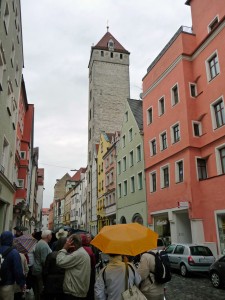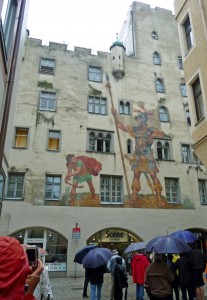 By Chris Millikan
By Chris Millikan
Dressed in rain gear, we disembark at Regensburg, Germany. On the dock, guide Helga peeks from under her umbrella, “In spite of this drizzle, our morning walking tour will reveal the historic character of our old city, a World Heritage Site since 2006.
Strolling a pathway along the Danube, she says, “Interestingly, Regensburg survived numerous wars over her long history. So, an astonishing collection of 1300 historic buildings awaits us…but don’t worry, we won’t be visiting them all today!”
Our group of history buffs soon huddles under an archaic stone gateway consolidated into a large building. Helga explains, “Called Porta Praetoria, this gate was part of the Roman’s second fortress, built in 179 AD. Their walled town developed into one of Germany’s oldest cities.”
Passing through this ancient entryway into a charming square, we sight the Cathedral of St. Peter with spires soaring in gothic glory. Founded in 1275, Bavaria’s monumental cathedral contains spectacular stained glass windows from the 13th and 14th centuries. Next door, Church of St. Ulrich archives religious art treasures from the diocese. To the east rises a 38-meter Roman tower over 1000 years old.
West of the cathedral, we wind past open-air cafes, taverns and boutiques. Above one cluster of shops, a four-story mural portrays David and Goliath. Helga explains, “That scene was painted in the 14th century on the front of a patrician castle. David symbolizes small, honest merchants and Goliath, giant, arrogant businessmen.” Walking onward, she points out the high towers on medieval mansions. “From the 11th to 13th centuries, nobles built them to demonstrate their great wealth.” The tallest, Golden Tower soars 50-meters upward, boasts nine floors…and flaunts a pyramid-shaped roof topped by a gold ball. Close by, gothic City Hall hosted the Holy Roman Empire’s Imperial Diet. Feudal lords and bishops governed here for over 150 years.
Down a walkway we sight the medieval Stone Bridge, a city icon. Helga explains, “Charlemagne built a wooden bridge 100-meters east of here…but it proved inadequate for the traffic and was vulnerable to floods. This famous 16 arch Stone Bridge replaced it in 1146…and became the model for other European bridges, including London Bridge on the Thames and Pont d’Avignon on the Rhone.”
Helga tells us how this was the Danube’s only bridge for 800 years. Regensburg prospered from its tolls as well as from its location on the lucrative trade routes between Venice and Northern Europe. During this golden age, wealthy mercantile families filled Regensburg. Recognized for gold work, luxurious/splendid/splendid fabrics…and high-rise towers…it was southern Germany’s cultural centre.
 Hearing that crusaders used this bridge on their way to the Holy Land, we picture armored knights on magnificent steeds thundering across with flags flying! Now reserved for pedestrians and bicycles, we ramble out onto the deck and look back at the old city, visualizing the city’s early protective walls and riverside salt stores. St. Peter’s 105-meter spires still dominate its skyline.
Hearing that crusaders used this bridge on their way to the Holy Land, we picture armored knights on magnificent steeds thundering across with flags flying! Now reserved for pedestrians and bicycles, we ramble out onto the deck and look back at the old city, visualizing the city’s early protective walls and riverside salt stores. St. Peter’s 105-meter spires still dominate its skyline.
Helga smiles, “At the end of the bridge, you can see our renowned Regensburg Sausage Kitchen. Originally a canteen for bridge workers in the 1400’s, it still sells the popular Knackersemmel, grilled sausages served with sauerkraut, sweet mustard…and gherkins. You must try one!”
One of the busy aproned ladies pops sizzling sausages into plump white rolls for us. Under a red and white striped awning, shipmates sit at a long table. Joining them we toast ‘Knackersemmel’ with robust local beer and happily bite into these traditional delights.
Over dinner back onboard our riverboat, all chat about Regensburg’s bygone age of elegance and splendor. Walking throughout old town inspired many insights into German culture…even in the rain!